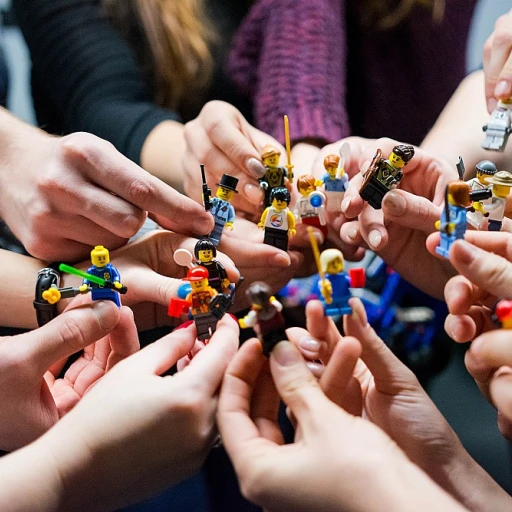
Understanding the Evolution of Talent
Tracing the Roots of Talent: From Innate to Acquired
Understanding the nature of talent has been a topic of keen interest and research over the years. Historically, talent was often seen as an innate characteristic, a gift given to a fortunate few. However, contemporary thinking suggests a more nuanced view of talent development, emphasizing the growth mindset and the importance of effort and practice over time. The shift from viewing talent as a fixed entity to understanding it as something that can be nurtured aligns with the concept of the growth mindset. This perspective reveals that intelligence and skills are not static but can be developed through hard work, dedication, and the consistent application of effort. In fact, data-driven insights from various studies indicate that anyone can enhance their abilities through deliberate practice and continuous learning. Through years of observation, experts have noted the significance of "myelin," a substance in our brains that plays a crucial role in skill development. When individuals engage in hours of practice, myelin thickens around neurons, improving their ability to perform a skill better. This biological facet underscores the importance of practice in transforming raw talent into refined expertise. Moving beyond traditional recruitment processes, hiring managers increasingly recognize that a candidate's potential is not solely based on their current skills or intelligence. Instead, it's about identifying those who demonstrate a capacity to learn and grow over time. This evolving understanding aids in developing talent more effectively and aligns with the core objectives of talent intelligence in modern-day workforce planning. This journey of growth is not without its hurdles. Life and career growth demand a willingness to embrace challenges, adapt to change, and continually seek improvement. By fostering an environment that supports learning and development, companies can help individuals transition from possessing innate talent to achieving high-level skills intelligence. For those embarking on the role of nurturing talent, exploring positions like digital talent management coordinator can offer insight into how talent can be managed and harnessed in today's dynamic world. Such roles are emblematic of the shift towards seeing talent as an evolving journey rather than a predefined destination.The Role of Intelligence in Career Growth
The Interplay of Intelligence and Career Advancement
In the dynamic landscape of career growth, intelligence plays a pivotal role in shaping an individual's journey. Intelligence, often perceived as an innate trait, is increasingly being understood as a multifaceted attribute that can be nurtured and developed over time. This shift in perspective aligns with the growing emphasis on digital talent management and the need for adaptable skills in the modern workforce.
The concept of intelligence extends beyond mere cognitive abilities. It encompasses a range of skills, including emotional intelligence, problem-solving, and the ability to learn and adapt. These skills are crucial for navigating the complexities of today's work environments. Hiring managers are increasingly looking for candidates who demonstrate a growth mindset, where the focus is on continuous learning and development rather than relying solely on innate talent.
Research suggests that intelligence is not fixed; rather, it can be enhanced through deliberate practice and effort. The development of myelin in the brain, for instance, is linked to the hours of practice and hard work put in over years. This biological process underscores the importance of sustained effort in honing one's skills and intelligence.
Moreover, the integration of data and tools in recruitment processes has enabled organizations to better assess the intelligence and potential of candidates. By leveraging these insights, companies can identify individuals who possess the right blend of skills and mindset for long-term growth and success.
In conclusion, intelligence is a key driver of career advancement, but it is not the sole determinant. A combination of effort, learning, and the right opportunities can significantly enhance one's ability to grow and succeed in their professional life. As we explore the evolution of talent and the impact of continuous learning, it becomes evident that intelligence is a dynamic attribute that can be cultivated and refined over time.
Identifying Potential in Candidates
Spotting the Shining Stars: Recognizing the Spark of Potential
In the intricate dance of recruitment processes, identifying potential in candidates stands as a cornerstone for building a successful team. This endeavor is deeply intertwined with understanding both talent and intelligence. However, very few recruitment processes embrace a growth mindset—leaning more often towards assessing innate talent. Yet, great hiring managers recognize that talent and intelligence are not fixed traits; they're nurtured over time through effort and practice. A keen eye for talent intelligence is crucial. This means not just evaluating the candidate’s current skills but also their ability to learn and develop talent in the long term. This requires a deep analysis and understanding of the candidates’ life experiences and accomplishments, considering how they have developed their skills and intelligence over the years.- Growth Mindset vs. Fixed Mindset: Promoting a growth mindset in evaluating candidates can significantly improve hiring outcomes. Candidates who possess a strong growth mindset are more likely to view challenges as opportunities for learning and development. They embrace hard work and understand that intelligence and talent are muscles to be strengthened, not innate gifts to rely on effortlessly.
- Long Term Potential over Immediate Skill: While immediate skills are essential, spotting potential often means looking beyond the surface. Hard data and tools can assist hiring managers in assessing long term potential, and understanding how effort can improve capabilities. As candidates transition through life, their ability to learn and practice their skills over time speaks volumes about their potential for growth. Considering how they approach hours of practice, and their developmental mindset, can offer insights into their likely trajectory within a role.
- Holistic Assessment: An effective hiring process involves a holistic approach. Myelin development, the education journey, and individual learning paths all influence how one’s intelligence and skills evolve. Focusing on these developmental aspects rather than solely on past accomplishments encourages spotting candidates who will create value over time, adapting and thriving in dynamic environments.
The Impact of Continuous Learning
Embracing a Growth Mindset for Continuous Learning
In the ever-evolving landscape of talent acquisition, continuous learning stands as a cornerstone for both individuals and organizations. The journey of nurturing talent and intelligence is not solely about recognizing innate abilities but also about fostering a growth mindset that encourages development over time. This mindset is crucial for adapting to the dynamic demands of modern careers.
Continuous learning is not just a buzzword; it is a vital component of talent development. It involves a commitment to improving skills and intelligence through consistent effort and practice. Research suggests that the process of learning and skill acquisition is akin to building myelin in the brain, which strengthens neural pathways and enhances performance. This biological perspective underscores the importance of sustained effort and practice over years to achieve mastery.
For hiring managers, identifying candidates who possess a growth mindset can be a game-changer. These individuals are more likely to embrace challenges, persist in the face of setbacks, and view effort as a path to mastery. They understand that intelligence and skills are not fixed traits but can be developed with time and dedication. This perspective aligns with the concept of talent intelligence, which emphasizes the ability to learn and adapt as a key indicator of potential success.
Organizations that prioritize continuous learning create an environment where employees are encouraged to develop their skills and intelligence. This approach not only enhances individual growth but also contributes to the overall success of the company. By providing tools and resources for learning, companies can foster a culture of development that benefits both employees and the organization in the long term.
In conclusion, the impact of continuous learning on talent development cannot be overstated. It transforms the recruitment process by shifting the focus from innate talent to the potential for growth and improvement. As the workplace continues to evolve, embracing a growth mindset and prioritizing continuous learning will be essential for both individuals and organizations striving for success.
Challenges in the Hiring Process
Overcoming Obstacles in Recruitment
In the dynamic world of talent acquisition, hiring managers face numerous challenges that can impede the identification and nurturing of potential. These obstacles often stem from the complex interplay of talent, intelligence, and mindset, which are crucial for long-term growth and development.
One significant challenge is the identification of innate talent. While some candidates may possess an inherent aptitude, others demonstrate their potential through hard work and a growth mindset. The ability to discern between these attributes requires a keen understanding of both intelligence and skills development over time.
Balancing Skills and Intelligence
Another hurdle is balancing the emphasis on skills intelligence with the recognition of effort and practice. Hiring managers must evaluate whether a candidate's abilities are the result of hours of practice or an innate intelligence talent. This evaluation is critical, as it influences the recruitment processes and the long-term success of talent development within an organization.
Embracing Continuous Learning
The impact of continuous learning cannot be overstated. Organizations that foster a culture of learning and development talent are better equipped to adapt to changing market demands. However, integrating learning tools and opportunities into the hiring process can be challenging, particularly when faced with high stakes and tight timelines.
Data-Driven Decision Making
Incorporating data into recruitment decisions is essential for improving outcomes. Yet, the use of data-driven tools can be daunting. Hiring managers must navigate the complexities of data interpretation to ensure they are making informed decisions that align with the organization's goals for growth and development.
Ultimately, overcoming these challenges requires a commitment to understanding the nuances of talent and intelligence. By fostering a culture that values both innate abilities and the capacity to learn and improve, organizations can create a more effective and resilient workforce.
Future Trends in Talent Acquisition
The Future of Talent Acquisition: Harnessing Change
The hiring landscape is shifting, integrating both traditional practices and forward-thinking methodologies. This evolution challenges hiring managers to refine processes by incorporating advanced tools that offer data-driven insights into a candidate's potential. As discussed earlier, understanding both talent and intelligence is key to career growth and recruitment. Emerging trends in talent acquisition emphasize the importance of developing talent through continuous learning. With a growth mindset, there is an increasing focus on nurturing skills and intelligence over time. This adaptive approach recognizes that while some individuals may have innate talent, the ability to learn and effort to improve can significantly impact their professional life.- The Rise of AI and Machine Learning Tools: These technologies can analyze specific skills and identify intelligence talent in candidates, streamlining the recruitment process.
- Data-Driven Decision Making: Leveraging data not only improves decisions in identifying potential but can also predict a candidate's long-term ability to learn and adapt.
- Continuous Learning and Development Programs: Encouraging a culture of learning within organizations helps in developing talent and supporting employees in their growth journey.
- Emphasis on Soft Skills: As hard skills can be easily taught, more emphasis is placed on identifying candidates with soft skills such as adaptability, communication, and a growth mindset.












